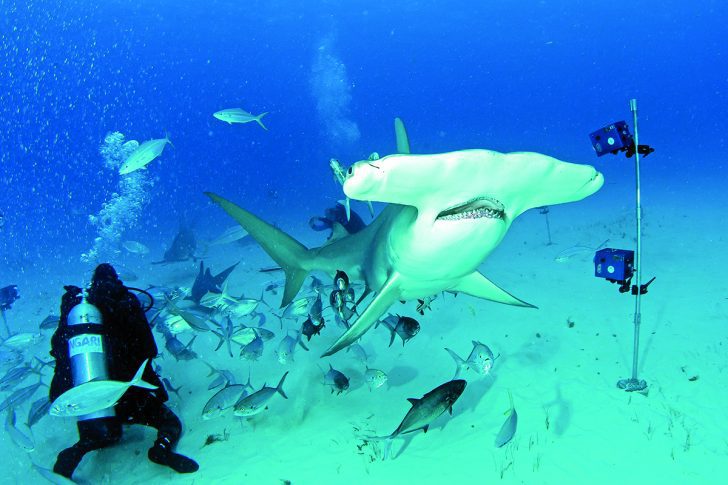
It was 5 p.m. on January 27th, and while standing on the dock next to R/V ANGARI the sun slowly faded behind a high-rise condo at Palm Harbor Marina. Scientist Duncan Irschick and underwater cinematographer Casey Sapp arrived on the dock and loaded gear onto the 65- foot research vessel. The ANGARI stood out amongst the pleasure boats at the marina with its impressive blue hull stripe and familiar ANGARI wave logo. Captain Angela Rosenberg greeted the passengers and got right to work going over sleeping accommodations and expected weather conditions for the 8 hour passage to The Bahamas. Early the next morning, they would depart ANGARI Foundation’s West Palm Beach headquarters for South Bimini to collect high quality underwater footage of a great hammerhead shark – a species known for visiting the Bimini area every winter.
Irschick is a professor of integrative biology at the University of Massachusetts – Amherst and the co-founder and director of the nonprofit Digital Life, which creates and distributes open-access high-resolution 3D models of life on earth. According to Irschick, “our group works with partners, such as ANGARI Foundation and others, to create models for three main purposes: science, education and conservation.”
This is not the first time ANGARI Foundation and Digital Life teamed up. Back in August 2018, R/V ANGARI traveled to Andros with Irschick and sea turtle expert Annabelle Brooks to collect data on green sea turtles. In Andros, Irschick did not have access to the high-end underwater gear that Sapp of VRTUL is now bringing to Bimini. Sapp’s synchronized multi-camera rig will collect 3D views of a swimming great hammerhead shark from all angles and provide Digital Life modelers with the necessary visualization and data to create high resolution and accurate animated 3D models.
As expected, January weather proved challenging and the team spent half of their days in the field and the other half at the dock. “You can’t control the weather so it’s important to make the most out of every good day you have,” said Rosenberg. The first field day had its ups and downs. Experienced shark feeder Sean Williams lured some great hammerhead sharks on site, but a strong current made equipment setup difficult, and there were some kinks to work out with the camera system.
After overcoming challenges, on the second day the team successfully recorded the movement of several hammerhead sharks with ten 4K cameras at 120 frames per second! The high resolution video they collected is now back at UMass serving its purpose to create accurate 3D models for scientific and educational use. “We believe that by collecting synchronized camera views of these sharks swimming, we will be able to study their movements more exactly,” said Irschick.
Not everyone will be lucky enough to have the incredible experience of diving with a great hammerhead shark during their lifetime, so bringing these magnificent animals to life is an educational and entertaining way to show the world how majestic and worth saving these animals truly are.